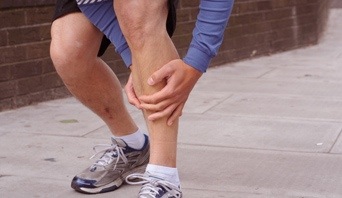Treating shin splints
Shin splints are small tears in the area where the lower leg muscle attaches to the tibia, aka the shin bone. The tears result from overuse, and since pavement taxes your muscles more than a treadmill, many runners complain of shin pain when they first begin outdoor runs. Shin splints often occur because the calf muscle becomes stronger than the tibialis anterior, the muscle on the outside of the shin. Even if the ache isn’t that bad, it’s still a minor injury. Pushing through the pain could result in more severe tears — an injury that could sideline your running routine altogether.
Keep reading to learn how to prevent shin splints.
Check your form: Are you a heel striker? Landing on the heel can result in shin splints splints, knee injuries, or a pulled calf muscle. To prevent shin pain, focus on landing midfoot rather than on the heel.
Strengthen the lower leg muscles: Since shin splints can be caused by muscular imbalance, strengthen the muscles in the lower legs by doing variations of walking on your toes and heels as well as this seated shin-strengthening exercise using a dumbbell.
Run on softer surfaces: During the Winter, this might not pose as big of an issue, but pavement is hard on the joints and muscles. As opposed to asphalt, running on dirt roads or woodsy trails could eliminate the pain immediately.
Don’t skip stretching: Make time for stretches that target the lower legs, including these seven calf stretches — even on days you don’t exercise — and this yoga pose that stretches the shins.
Don’t just run: Cross-train with other types of exercise to strengthen all your muscles and to maintain flexibility. Bike, swim, hike, walk, do yoga, and hit the weight room at your gym.
Rest: Some days of rest are in order, but that doesn’t mean you have to stop all physical activity. Do low-intensity exercise that doesn’t aggravate your shins, such as walking or swimming laps. If resting doesn’t help, then make an appointment with your doctor to ensure it’s not something more serious like a stress fracture.
Ice, ice baby: Taking a full ice bath may not be the best idea during the colder months, but using an icing cup for massage protects your fingers from freezing and provides a perfectly sized contact point for troubled shins.
Roll out: A foam roller can be part of your best defense against shin splints. When you feel the pain start, this simple foam rolling move can ease the ache.
Add an incline: Running on flat or downhill ground can make you more susceptible to painful shin splints by putting pressure on your shinbones, but running uphill can alleviate that stress (just be careful when you head down!).
Ease into outdoor runs: Once the weather warms up, don’t expect to be able to run at an eight-minute-mile pace for 45 minutes straight like you could on the treadmill. Wind resistance, uneven terrain, and the lack of a moving belt to propel your steps makes for a much harder workout. Doing too much too soon is a surefire way to end up with shin splints or another injury, so slow down your pace, run shorter distances, and don’t be ashamed to take walking breaks when necessary.
 Follow
Follow





Leave a Reply